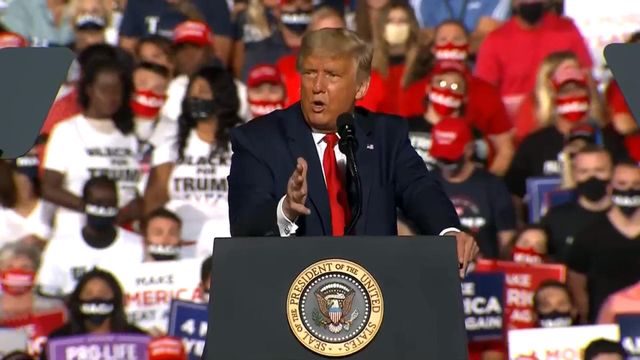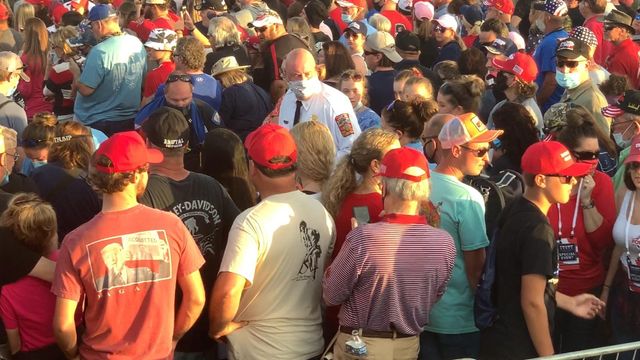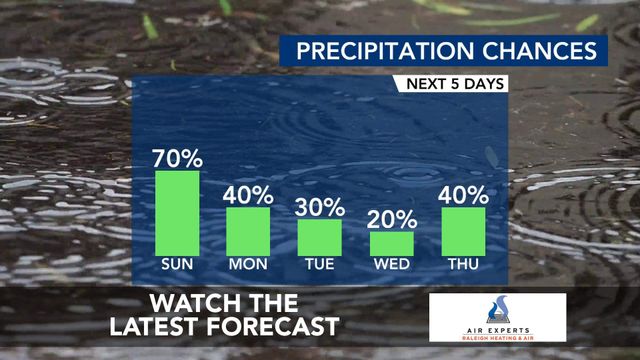Why Trump can't take red counties in North Carolina for granted
Republicans in Gaston County still have pictures from the last time a presidential candidate visited here during a general election: They are sun-stained images from 1992, when President George H.W. Bush’s Spirit of America train tour made a stop in the town of Ranlo, North Carolina.
When residents heard that President Donald Trump was planning a rally in Gastonia, they reacted with a mix of small-town pride and general confusion. He won the county in 2016 with 64% of the vote; have things gotten so bad for Trump in the suburbs of America that he needed to spend time here two weeks before Election Day?
“What I’m seeing in my online communities is that people immediately laughed,” said Courtney Phillips, a stay-at-home mother who has been involved in grassroots organizing for the Biden-Harris campaign. “Why is he coming here? Is he really worried about Gaston County?” Tens of thousands of people ultimately turned out for Wednesday night’s rally, indicating that this red county, at least, had an energized Trump base. “People had to park at the mall,” she said.
In this final sprint of the campaign, Trump is now holding up to three rallies a day to try to “juice” his base, in the words of advisers, as he bleeds support among the suburban voters who helped fuel his victory in 2016. His trip to this bedrock Trump county, and to Wisconsin and Ohio suburbs and exurbs Saturday where his once-solid support is sliding, reflect his need to energize as much of his base as he can since many swing voters are now behind former Vice President Joe Biden, and there are few undecided voters left.
Gastonia is only about a half-hour west of downtown Charlotte, but once you cross the county line at the Catawba River, you are in die-hard Trump country. The only Democrat elected countywide here is the sheriff, who shares the president’s positions on guns and immigration. Trump flags fly in front of many houses, and lawn signs with his name dot the highways. “He isn’t a perfect president, but I am more proud of him now than I ever was before,” said Sandy Caudle, who works for a wholesale distributor and had two Trump banners displayed with his Halloween decorations on his front porch in the town of Lowell.
Four years ago, Trump’s outsize win in this district helped him toward an overall victory in North Carolina by a slim margin of 3.6 percentage points. A New York Times/Siena College poll this month of likely voters in the state showed Biden leading Trump by 4 points.
Lawn signs and campaign posters for Biden in this area are rare sightings. People like Karen Brown, who had a modest Biden-Harris sign displayed on her front yard in Gastonia, said she could not find one anywhere in town and finally resorted to ordering the $10 sign from Amazon.
Trump’s appearance in this town of 77,000 Wednesday — where he referred to President Barack Obama by his middle name, “Hussein,” and claimed, inaccurately, that the virus was “rounding the corner” — was not intended to win back the suburban women voters who have drifted away from him over the past four years. That is a hill too steep to climb at this point in this state: Some internal polls show Trump trailing Biden by double digits in the suburbs. The rally’s purpose, campaign aides said, was to activate his base. There was the added practical matter of simply securing a friendly venue in the middle of a pandemic that would allow him to hold a mass gathering for more than 20,000 fans. “They don’t go to Raleigh or Charlotte,” said Morgan Jackson, a Democratic strategist based in North Carolina. “They’re going to Gastonia and Selma and Greenville. They’re playing the outer game to rally his base. They’ve given up on the Mecklenburg County suburban area. I think they’ve given up here on those votes.”
The Trump campaign’s decision to send the candidate to a conservative county he is sure to win may not be a sign of strength. But it is probably his best shot at rallying enough voters to prevail in North Carolina, where Trump’s most optimistic campaign officials think he will eke out a victory margin of less than 100,000 votes (four years ago, Trump won the state by about 173,000 votes).
Bleeding votes in the Mecklenburg County suburbs, Trump can afford no cracks in his support in the districts he won four years ago. In fact, he has to win bigger here.
“In a year like this, in an election like this, a point or two in a community like Gaston County could determine the statewide race,” said Rep. Patrick McHenry, R-N.C.
Michael Whatley, chair of the North Carolina Republican Party, said a rally in Gastonia still hit the Charlotte and Asheville media markets and that the party was still investing in a ground game in Charlotte suburbs like Matthews. But, he conceded, “We do need to do better in Gaston County, just because of the number of people who have moved in. A vote from Gaston County is the same as a vote from Charlotte.”
In Gaston County, “we’re hitting targeted voters with phone calls and door-knock teams and the biggest mail program we’ve ever run,” Whatley said. With up to 75% of votes expected to come in before Election Day, Whatley also noted that the state party moved its mail program earlier. “We’re going after targeted voters there, making sure they’re aware of early voting and how to do it.” The party has had 200,000 voter contacts in Gaston County. “We’ve spent a lot of time working those counties very aggressively,” he said.
J. Michael Bitzer, a professor of U.S. politics at Catawba College in Salisbury, North Carolina, said he had seen nothing from the Trump campaign that would indicate its hopes for victory in the state lie with converting more of the voters in the urban suburbs that Hillary Clinton won four years ago by 1 percentage point. “The way I look at this race is, what’s the shift in those urban suburbs to Biden, and what are the Republican margins in those surrounding suburban areas,” he said.
The Trump campaign has been aware for months that the urban suburbs are slipping away. The narrow victory by Rep. Dan Bishop, a Republican, last year, underscored the party’s deepening unpopularity with suburban voters, this time in the Charlotte suburbs. And Republicans in the state said Trump was currently performing worse than he did four years ago in Mecklenberg County, which includes Charlotte and its suburbs.
They attribute the slippage to Trump’s behavior. People inside and outside the campaign pointed to his performance in the first presidential debate as well as to his hospitalization for the coronavirus — a grim symbol of his handling of the virus crisis overall — as turning off voters who are not convinced of Biden’s policies.
“Theoretically, could Donald Trump stop the bleeding in the suburbs? The answer is maybe,” said Geoff Garin, a Democratic strategist working with Priorities USA, a Democratic super political action committee. “Can Donald Trump stop the bleeding in the suburbs, given who he is and the way he’s conducting himself? The answer to that question is definitely no.” The coronavirus remains the top issue for suburban voters, Garin said, and Trump “seems intent every day to demonstrate that he doesn’t take it seriously and that he’s part of the problem.” What may turn the president off to those voters has endeared him to the population in the exurbs.
“If he didn’t have rallies, there would be no way to get his message out,” said Stephanie Nixon, a pharmacist who was volunteering at a poll site Thursday dressed in a “Women for Trump” T-shirt. “I think he has to do it. I understand the risks, but I understand why close to 30,000 people went.” Even in a Republican district, Nixon said she felt that being a Trump supporter put a target on your back.
“We’re the silent majority,” she said. “When I told my mom I was wearing this shirt, she said, ‘You’re brave.’”
Despite the heavy Trump presence here and an overall lack of Biden lawn signs, Democrats and independents said they saw changes in their community that made them feel hopeful that they were creating a blue ripple that could deprive Trump of the state’s 15 electoral votes. The town of Gastonia, they said, has become a blue speck in a red county, with a majority Democratic City Council for the first time in recent history. And some said they saw new cracks here in the president’s support.
“I’m in two very intimate groups: a book club and a bridge club,” said Jennie Stultz, a former mayor of Gastonia. “We are made up of staunch Democrats and staunch Republicans. Women have become disenchanted with the incivility of the president.”
Pam Morgenstern, a volunteer poll greeter, said that over her 10 years living in Gaston County, she had never seen as much engagement on the Democratic side as she had seen in the past few months, when she has helped organize “Ridin’ with Biden” events and block parties. She said she attributes some of the change to Democratic voters being priced out of Charlotte and moving west. “In 2016, the Clinton campaign did send an organizer here, and we had a headquarters,” she said. “But people didn’t like Hillary as much. We didn’t have the enthusiasm we are seeing now.”
On Thursday morning, Morgenstern was handing out campaign literature at an early-voting polling site in Cramerton alongside Barbara Brown, whose husband, David Wilson Brown, is running a long-shot Democratic campaign for Congress against the Republican incumbent, Rep. Virginia Foxx.
Barbara Brown said she had stocked up on groceries before the president’s visit in order to be able to quarantine and better protect herself from potential exposure to the virus in the days after the rally.
Despite her increased anxiety about the virus, she said the rally also made her hopeful.
“They have to come here because we’re doing a kick-ass job,” she said. “That’s why they’re coming.”













